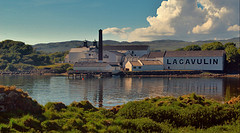“Yeah, right,” I hear you say… and that’s pretty much what I thought as well. But a new study says that, on paper at least, an all-renewable energy infrastructure could be built within just two decades of today… and built is the operative word:
Achieving 100 percent renewable energy would mean the building of about four million 5 MW wind turbines, 1.7 billion 3 kW roof-mounted solar photovoltaic systems, and around 90,000 300 MW solar power plants.
[…]
Delucchi and colleague Mark Jacobson left all fossil fuel sources of energy out of their calculations and concentrated only on wind, solar, waves and geothermal sources. Fossil fuels currently provide over 80 percent of the world’s energy supply. They also left out biomass, currently the most widely used renewable energy source, because of concerns about pollution and land-use issues. Their calculations also left out nuclear power generation, which currently supplies around six percent of the world’s electricity.
To make their vision possible, a great deal of building would need to occur. The wind turbines needed, for example, are two to three times the capacity of most of today’s wind turbines, but 5 MW offshore turbines were built in Germany in 2006, and China built its first in 2010. The solar power plants needed would be a mix of photovoltaic panel plants and concentrated solar plants that concentrate solar energy to boil water to drive generators. At present only a few dozen such utility-scale solar plants exist. Energy would also be obtained from photovoltaic panels mounted on most homes and buildings.
Of course, the technological plausibility of an all-renewable energy economy has always been theoretically understood. So why does it seem so unbelieveable?
The pair say all the major resources needed are available, with the only material bottleneck being supplies of rare earth materials such as neodymium, which is often used in the manufacture of magnets. This bottleneck could be overcome if mining were increased by a factor of five and if recycling were introduced, or if technologies avoiding rare earth were developed, but the political bottlenecks may be insurmountable.
Ah, yes – the p-word. Might’ve guessed that’d crop up in there somewhere. The saddest thing of all is the lost opportunities for political solutions that pushing for even a quarter of this vision would create: massive building programs would create loads of jobs and envigorate flagging economies, at the same time as removing major sources of atmospheric pollution and the incentive to go to war over increasingly scarce fossil fuel resources. Pretty much everyone would stand to benefit… except that tiny percentage of people currently profiting from the status quo, of course.
But were I to suggest that they were involved in spending millions of dollars on obfuscatory political chicanery and misiniformation campaigns to prevent the status quo from shifting, why, I’d be some sort of rabid conspiracy theorist! After all, everyone knows the real conspiracy is being masterminded by neoMarxist extremists masquerading as climate scientists, right? Right?
[ I really shouldn’t need to point out that the last few sentences there are meant to be read with a tone of extreme sarcasm, but – what with this being the internet – consider this a disclaimer to that effect. And to pre-empt the other obvious objection, I strongly suspect the 100%-by-2030 projection is ludicrously optimistic, even were global agreement and cooperation toward that aim within grasp; however, the underlying point is that the technology exists right now, and we’re not using it to even a fraction of its potential. ]
 The remote Scottish island of Islay suffers from irregular electricity supply thanks to being separated by the sea from the the soon-to-be-decommissioned Hunterston nuclear reactor on the mainland.
The remote Scottish island of Islay suffers from irregular electricity supply thanks to being separated by the sea from the the soon-to-be-decommissioned Hunterston nuclear reactor on the mainland.